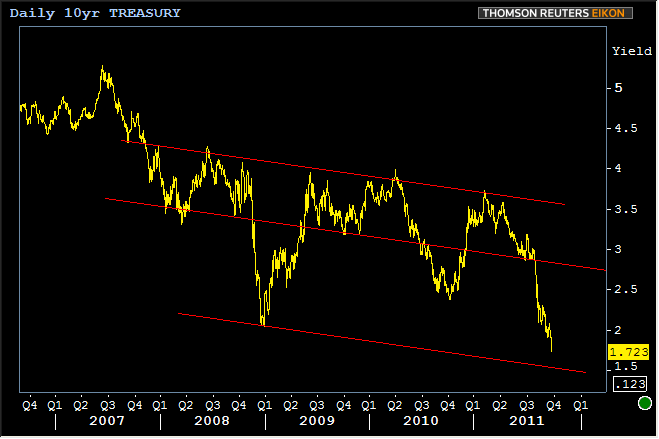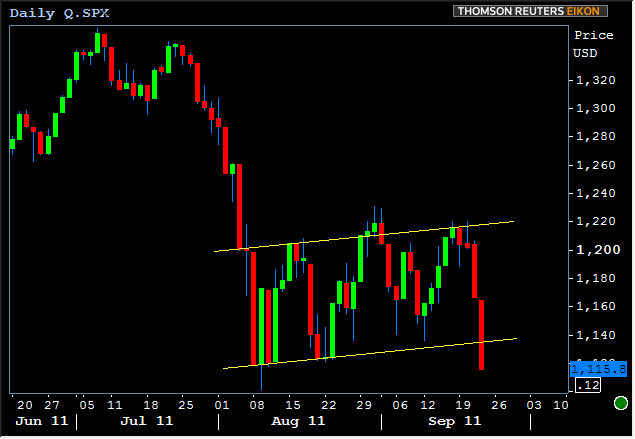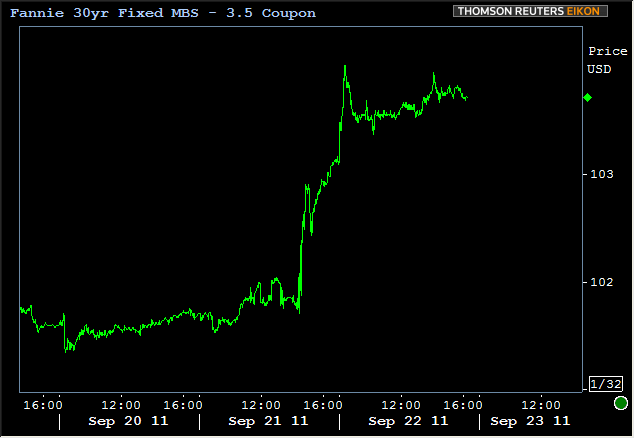First of all, let's be clear: we're not saying 10yr yields are definitely going to 1.5%. But we've heard the news that some folks think it's possible and frankly, so do we. When we first charted "history repeating," I remember thinking to myself that the historical precedent led 10yr yields lower than I was comfortable predicting. This wasn't necessarily because I didn't think it was possible, but at that time, a 1.5% claim might have raised more eyebrows than it was worth. Not even four months later though, and that's changed. Here's why:
Bottom line, it's all about the trends. The 3 lines below fall along a slope that hooks up so many highs and lows in 10yr yields over the past 3 years that it boggles the mind. We only include 3 of those lines here, but with the exception of the 3 major rallies, the top two lines have governed ALL the market movement during that time. No need to overcomplicate the explanation from there... It's as simple as taking the same slope, and drawing a line from the late 2008 lows. That would put things right at 1.5 in the near future. Whether or not that means "tomorrow," "next week," or "early next month," is less clear, but certainly, the concept of history repeating itself continues to hold up well. So we'd continue to entertain it as a possibility until it's clear that the trend has been broken.

10's would likely need some cooperation from stocks--the same sort of cooperation that was seen heading into the 2pm hour today when stock selling accelerated past some technical support, causing concerns of a broader sell-off. Here's a look at the recent support in stocks being broken today:

I personally really like the trend channel in the above chart. It captures everything, remains pertinent throughout the last two months, and the only time you can fault it occurs on 8/31 (we can make some exceptions for month end considerations) and in low volume. So this looks like it could be a break lower from the recent trend, but as you may have heard us say in the past, it would take prices closing outside the trend yet again tomorrow in order to confirm. If that happens however, we have to start looking at LONG term charts for indications of where we might go next.
Caveat: this isn't the only technical analysis that's pertinent to S&P's, but the following chart shows the 500 day moving average on a LONG term S&P chart. Note that the index has only definitively broken the 500dma 4 times, EVER, with the exception of the past two months where we have bounced back and forth over the thing incessantly. This seems to suggest the moving average is either A) not a valid technical indicator or B) unprecedented market movements are transpiring and the indicator is in the process of undergoing an extended period of "testing." We'd lean toward the latter. It leaves us with possibilities for a bounce or a bigger sell-off. What do you see?

If you're like most today, all you see are rate sheets. No question we're looking at the most aggressive pricing of all time. Fannie 3.5's have turned into MBS Central effectively overnight:

The break above 102-00 (concrete ceiling was actually at 101-25) was a long time coming and a heavily resisted move. There's enough spread between MBS and 10yr notes to assume that investors won't be quick to abandon their newfound 3.5 coupon bucket, unless of course the global economic situation deteriorates further and another period of indecision crops up over staying in 3.5's vs moving down to 3.0's. But we wouldn't put the odds of that much higher than 1 in 3 for now.
On a final note, please be a team player and keep in mind that pricing inconsistencies right now don't really have anything to do with lenders being "greedy" or "stingy." The rapid pace of movement in bond markets makes secondary hedging protocol a nightmare to navigate right now. Being from an origination background (as opposed to secondary), believe me, I know the temptation to wish that lenders were passing along more of the gains, but for reasons that will have to wait for another post in the near future, I promise you they can't. Ultimately, a more gradual move lower in rates relative to MBS prices and even benchmark interest rates is a GOOD thing for the longevity of low rates in general.





